
CCLF
Return to home page
Venous Ulceration
"Manual Lymph Drainage (MLD) is an excellent treatment for the swelling of the legs associated this venous ulceration and lymphoedema. MLD is a very underrated treatment and should be more widely avaliable."
Mr Gaunt, Consultant Vascular Surgeon, Cambridge.
Treatment with Complex Decongestive Therapy (CDT) and the Feldenkrais Method.
Veins which are unhealthy tend to widen and sag and in a leg with low tissue pressure are unable to absorb sufficient tissue fluid into the bloodstream. Therefore, the lymphatic vessels have to transport a greater load of tissue fluid than normal. They may carry this extra load for some time, perhaps weeks or months, but eventually they ‘tire’ and the load becomes greater than the lymphatic system is capable of transporting. Fluid which contains waste products from the cells is left in the tissues causing oedema. Cells begin to die. Eventually fluid forces its way out of the skin and a venous ulcer results.
The oedema must first be relieved by Manual Lymph Drainage (MLD), combined with application of compression bandages and later hosiery (Complex Decongestive Therapy (CDT). Compression increases tissue pressure which pushes more tissue fluid into the veins. It also greatly improves the action of the venous muscle pumps: relaxation and contraction of the calf muscles assist in driving blood present in the veins towards the heart. Valves in the veins prevent backflow of the blood, though dilated veins do not fully close and some backflow occurs. Compression helps to narrow dilated veins.
Ankle movement is vital to muscle pump efficiency; many patients with leg oedema problems will also have stiff ankles. It is the Feldenkrais Method®, which has proven most effective here.
CDT Treatment:
- Manual Lymphatic Drainage (MLD) is always given.
- Bandaging may be necessary.
- You need to wear correct compression hosiery.
- Lymphoedema and Chronic Venous Insufficiency (CVI) requires special skin care.
- You will learn special exercises and receive specific Feldenkrais lessons to keep your swelling down and use your feet and ankles efficiently.
- You might be taught to do MLD for yourself.
- We will teach you about the lymphatic system and how to care for CVI.
- Patient participation is vital for good results.
What are the effects of Manual Lymph Drainage?
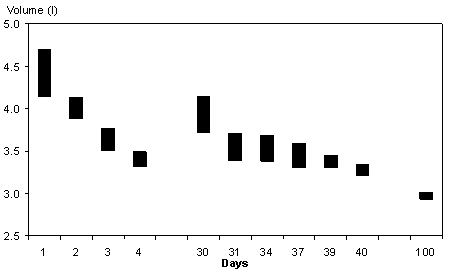
This graph shows the changes in volume of the left lower leg of a patient with CVI, before and after each treatment, over a period of 40 days and then again 60 days later. The increase in volume on day 30 resulted from an inflammation. This patient received MLD and was bandaged for two weeks before being fitted with compression hosiery. The reduction in volume over 100 days equates to an overall loss of ~ 1.8 litres from the lower leg. The end results of this patient has been so good that he has had treatment for only 3 more times since October 2002. He wears his compression hosiery without fail and excercises daily.
What are the effects of the Feldenkrais Method?
With CVI patients, neither the valves of the veins or the muscle pump work properly, due to inefficient walking. Stiffening in the ankle creates poor action of the foot when walking. The foot does not roll efficiently, rendering the muscle pump inactive. If a patient is given instructions to 'walk properly', they will fall back into their non-efficient habitual pattern as soon as they stop concentrating.
The Feldenkrais Method offers lessons by which patients spontaneously adopt a more efficient way of walking, without having to think about it. Other Feldenkrais lessons will effectively reduce swollen ankles.
On a psychological level, medical exercises remind patients that they are 'ill' and become a chore that the patient has to do. The Feldenkrais Method has a much more positive philosophy in its lessons. Exercising is more pleasurable, exciting and fun. This improves self-image, which is of great importance to anyone wanting to get well. Very importantly, Feldenkrais lessons reorganise the whole skeleton, which relaxes muscle strain (not healthy muscle tone) throughout the body. Attention is never restricted and focused to one part of the body but instead improves well-being throughout the whole person.
Case 1:
Chronic Venous Ulceration
Treatment with CDT and Feldenkrais of a Phlebo-Lymphostatic oedema.
This patient had a 60 year history of chronic persistant leg ulcers with significant difficulty in walking.
 |
 |
After 16 treatments the leg improved with the healing of the ulcers, reduced oedema, improved skin condition and mobility.
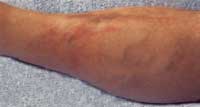 |
 |
Case 2:
Chronic Venous Ulceration
Bilateral deep venous incompetence not amenable to surgery. This patient is troubled with significant bilateral venous eczema over both medial malleoli and recurrent ulceration.
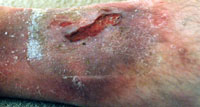 |
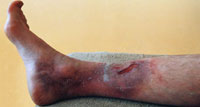 |
After twelve treatments of CDT involving manual lymphatic drainage, skin care using Spirig Lipoderm Omega, multi-layer compression bandaging and Feldenkrais exercises, there is great improvement in the skin and ulcer. The patient was fitted with made to measure Jobst class 2 knee-high compression hosiery after nine treatments.
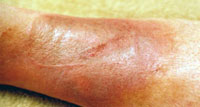 |
 |
Case 3:
Bilateral lymphoedema below the knee, worse on left.
After eight treatments of CDT involving manual lymphatic drainage, multi-layer compression bandaging and Feldenkrais exercises. The patient now wears made to measure Jobst class 2 knee-high compression hosiery.
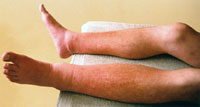 |
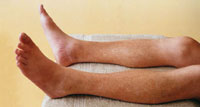 |
"After being referred by my GP I have had several lymphoedema sessions with Mrs Tribe and her daughter and I would readily recommend them to family and friends for the excellent service they have given me. I think they should be recognised by the NHS."
R.Griggs, CVI with Lymphoedema
"I was referred to Mrs Tribe by my doctor, as I had suffered from swollen ankles for many years, coupled with bouts of cellulitis over the last two years. The treatment has made a significant difference to the circulation in my legs and has virtually eliminated the swelling in my ankles. I can recommend Mrs Tribe’s treatment without hesitation. It is a pity that it is not readily available on the NHS."
S. Armour, recurring cellulitis with Lymphoedema
Your case history will be required from your GP before you come for treatment.
Sessions last one and a half hours.
Price: We have a sliding price scale which depends on how often you need to come for treatment. This varies from person to person and we can only say how often you would need to come after the first consultation.
First consultation is free if no treatment is given.
£90 per 90 minute session. Some reductions may be avaliable. Bupa recognised.
Call 07746 964151 or email us for more information.
Return to top of this page
Return to home page
Cambridge Centre for Lymphology and Feldenkrais (CCLF)
283 Milton Road
Cambridge CB4 1XQ, England
Tel: 07746 964151
Email: tina@cclf.co.uk
© CCLF 2024. All Rights Reserved. All Trademarks Acknowledged.